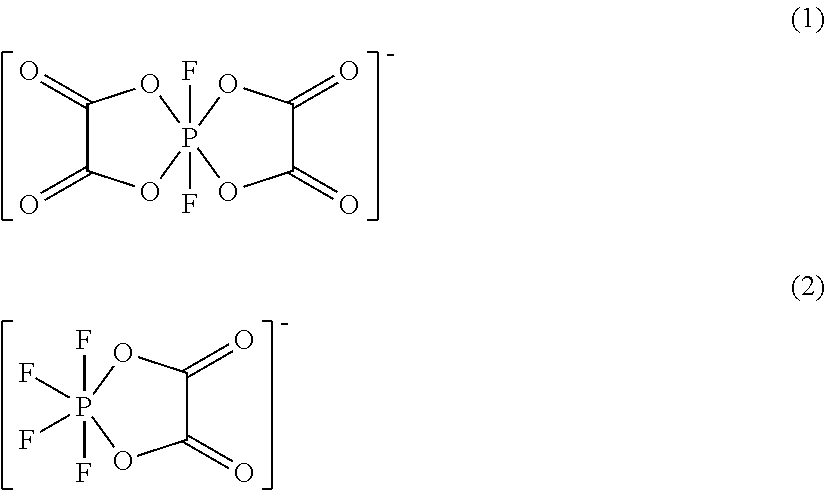Electrolyte for Non-Aqueous Electrolyte Batteries and Non-Aqueous Electrolyte Battery Using the Same
- Summary
- Abstract
- Description
- Claims
- Application Information
AI Technical Summary
Benefits of technology
Problems solved by technology
Method used
Image
Examples
example 1
[0041]An electrolyte for a non-aqueous electrolyte battery was prepared by mixing LiPF6 as a solute, lithium difluorobis(oxalato)phosphate and lithium tetrafluoro(oxalato)phosphate with a mixed solution of ethylene carbonate, dimethyl carbonate and ethyl methyl carbonate in a volume ratio of 1:1:1 such that the electrolyte contained 1.0 mol / L of LiPF6, 0.5 mass % of lithium difluorobis(oxalato)phosphate and 0.05 mass % of lithium tetrafluoro(oxalato)phosphate.
[0042]Using this electrolyte in combination with LiCoO2 as a positive electrode material and graphite as a negative electrode material, a battery cell was produced by the following procedure. A paste was prepared by mixing 90 parts by mass of LiCoO2 powder, 5 parts by mass of polyvinylidene fluoride (PVDF) as a binder and 5 parts by mass of Acetylene Black as a conductive agent and adding N-methylpyrrolidone to the mixture. The prepared paste was applied to and dried on aluminum foil, thereby forming a sample positive electrode...
example 2
[0045]An electrolyte was prepared in the same manner as in Example 1, except that: lithium difluorobis(oxalato)phosphate was added in an amount of 0.1 mass % to the electrolyte; and lithium tetrafluoro(oxalato)phosphate was added in an amount of 0.01 mass % to the electrolyte. A battery cell was produced using the prepared electrolyte and subjected to charge / discharge cycle test in the same manner as in Example 1.
[0046]The discharge capacity retention of the battery cell after 500 charge / discharge cycles was 79%; and the low-temperature characteristics of the battery cell after 500 charge / discharge cycles was 64%.
example 3
[0047]An electrolyte was prepared in the same manner as in Example 1, except that: lithium difluorobis(oxalato)phosphate was added in an amount of 3.0 mass % to the electrolyte; and lithium tetrafluoro(oxalato)phosphate was added in an amount of 0.5 mass % to the electrolyte. A battery cell was produced using the prepared electrolyte and subjected to charge / discharge cycle test in the same manner as in Example 1.
[0048]The discharge capacity retention of the battery cell after 500 charge / discharge cycles was 91%; and the low-temperature characteristics of the battery cell after 500 charge / discharge cycles was 65%.
PUM
 Login to View More
Login to View More Abstract
Description
Claims
Application Information
 Login to View More
Login to View More - R&D
- Intellectual Property
- Life Sciences
- Materials
- Tech Scout
- Unparalleled Data Quality
- Higher Quality Content
- 60% Fewer Hallucinations
Browse by: Latest US Patents, China's latest patents, Technical Efficacy Thesaurus, Application Domain, Technology Topic, Popular Technical Reports.
© 2025 PatSnap. All rights reserved.Legal|Privacy policy|Modern Slavery Act Transparency Statement|Sitemap|About US| Contact US: help@patsnap.com

